
Swainsona galegifolia commonly known as smooth Darling pea, is a species of flowering plant in the family Fabaceae and is endemic to Australia. It is a small shrub with greyish-green leaves and flowers in white, red, pink, purple, yellow or orange.

Pultenaea scabra, commonly known as rough bush-pea, is a species of flowering plant in the family Fabaceae and is endemic to south-eastern continental Australia. It is an erect or spreading shrub with hairy stems, heart-shaped leaves with the narrower end towards the base, and yellow and red, pea-like flowers.
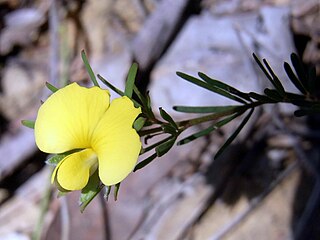
Gompholobium glabratum, commonly known as dainty wedge-pea, is a species of flowering plant in the family Fabaceae and is endemic to south-eastern continental Australia. It is a low-lying or ascending shrub with pinnate leaves that have five to seven leaflets, and yellow and green or greyish flowers.
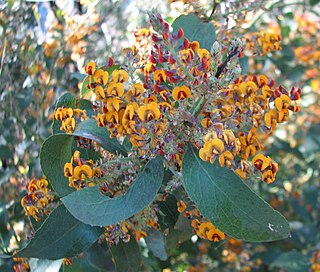
Daviesia latifolia, commonly known as hop bitter-pea, is a species of flowering plant in the family Fabaceae and is endemic to south-eastern Australia. It is a slender, erect, spreading shrub with elliptic, egg-shaped or lance-shaped phyllodes and orange-yellow and maroon flowers in long racemes.

Oxylobium arborescens, commonly known as the tall shaggy-pea, is a species of flowering shrub to small tree in the family Fabaceae and is endemic to south-eastern Australia. It has elliptic dark green leaves and yellow pea flowers.

Bossiaea cinerea, commonly known as showy bossiaea, is a species of flowering plant in the family Fabaceae and is endemic to south-eastern Australia. It is an erect or spreading shrub with trowel-shaped, triangular, egg-shaped or lance-shaped leaves with a sharply-pointed tip and golden yellow and red to purplish-brown flowers.

Melaleuca densa is a shrub in the myrtle family, Myrtaceae and is endemic to the south-west of Western Australia. It is a bushy shrub with profuse cream, yellow or greenish flowers and overlapping leaves on the youngest shoots.

Daviesia mimosoides, commonly known as blunt-leaf bitter-pea, narrow-leaf bitter pea or leafy bitter-pea, is a species of flowering plant in the family Fabaceae and is endemic to eastern continental Australia. It is an open shrub with tapering, linear, elliptic or egg-shaped phyllodes, and groups of orange-yellow and dark brownish-red to maroon flowers.
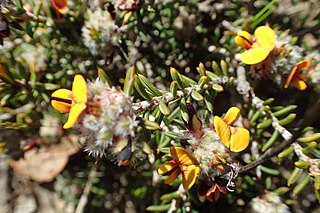
Pultenaea barbata is a species of flowering plant in the family Fabaceae and is endemic to the south of Western Australia. It is a prostrate or spreading, spindly shrub with hairy, needle-shaped leaves and yellow, red, orange or brown flowers with red or yellow markings.
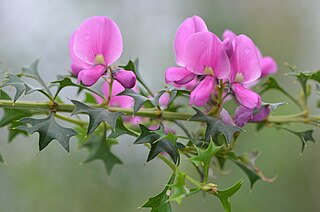
Mirbelia dilatata, commonly known as holly-leaved mirbelia, is a species of flowering plant in the family Fabaceae and is endemic to the south-west of Western Australia. It is an erect, bushy, shrub with prickly leaves and pink, purple or violet flowers.
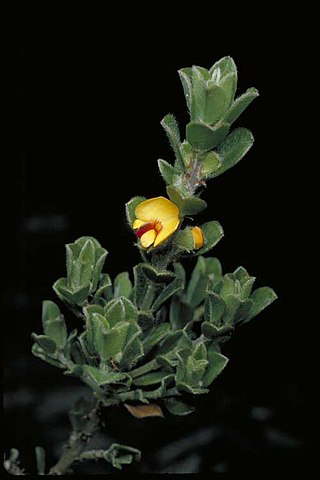
Pultenaea heterochila is a species of flowering plant in the family Fabaceae and is endemic to the south of Western Australia. It is an erect, low-lying or prostrate shrub with hairy leaves and yellow and red flowers.
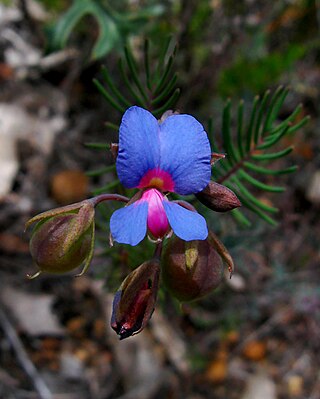
Gompholobium cyaninum is a species of flowering plant in the family Fabaceae and is endemic to the south-west of Western Australia. It is an erect to straggling shrub with pinnate leaves and blue, purple and red, pea-like flowers.

Gompholobium marginatum is a species of flowering plant in the family Fabaceae and is endemic to the south-west of Western Australia. It is a prostrate or low, spreading shrub with palmate leaves and uniformly yellow, pea-like flowers.
Gompholobium muticum is a species of flowering plant in the family Fabaceae and is endemic to the south-west of Western Australia. It is a low, bushy shrub with grooved, cylindrical leaves and pink or green, pea-like flowers.
Gompholobium obcordatum is a species of flowering plant in the family Fabaceae and is endemic to the south-west of Western Australia. It is an erect, open shrub with heart-shaped leaves, the narrower end towards the base, and uniformly yellow, pea-like flowers.

Gompholobium preissii is a species of flowering plant in the family Fabaceae and is endemic to the south-west of Western Australia. It is an erect shrub with pinnate leaves with five to fifteen leaflets, and yellow, red and orange, pea-like flowers.
Gompholobium subulatum is a species of flowering plant in the pea family Fabaceae and is endemic to northern Australia. It is a slender, erect shrub with pinnate leaves with five to eleven leaflets, and uniformly yellow, pea-like flowers.

Gompholobium venustum, commonly known as handsome wedge-pea, is a species of flowering plant in the family Fabaceae and is endemic to the south-west of Western Australia. It is a slender, erect or sprawling shrub with pinnate leaves with fifteen to nineteen leaflets, and yellow or pink, pea-like flowers.
Gompholobium viscidulum is a species of flowering plant in the pea family Fabaceae and is endemic to the south-west of Western Australia. It is an erect shrub with pinnate leaves with five to seven leaflets, and yellow flowers.
Pultenaea vestita, commonly known as feather bush-pea, is a species of flowering plant in the family Fabaceae and is endemic to south-western continental Australia. It is an erect to prostrate, sometimes mat-forming shrub with elliptic to linear or lance-shaped leaves, and yellow and red, pea-like flowers.
















